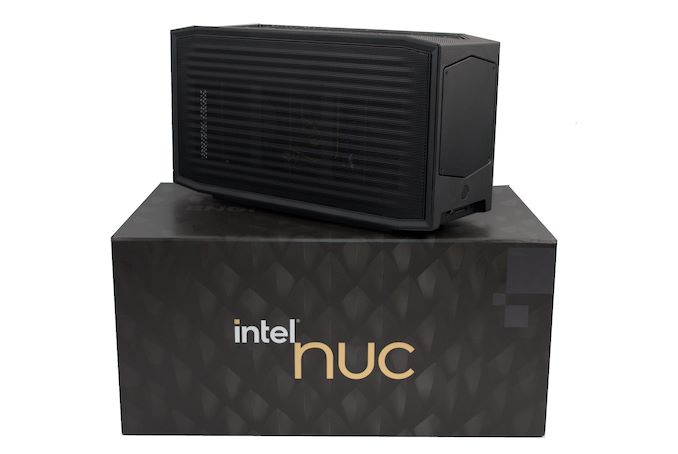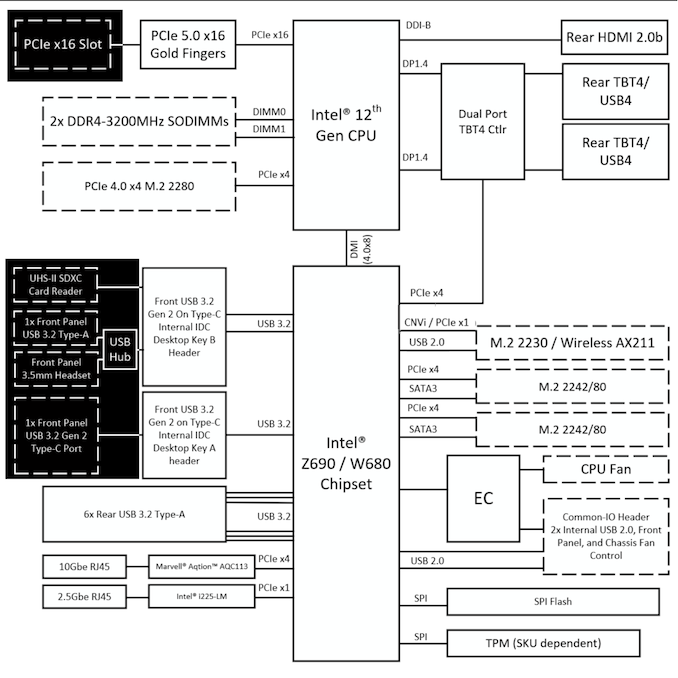The Intel NUC12 Extreme Dragon Canyon Preview: Desktop Alder Lake Impresses in SFF Avatar
by Ganesh T S on February 24, 2022 10:45 AM EST- Posted in
- Systems
- Intel
- NUC
- NUC12
- Dragon Canyon
Setup Notes and Platform Analysis
The review sample of the NUC12DCMi9 came package in a fancy casing, signifying its premium nature. Since the review configuration was a DIY configuration, the package contents only included the main unit, power cord, and a USB key containing the drivers for the system. The retail packaging is bound to be quite different, as these pre-production samples are packaged to make unboxing videos attractive.
The NUC12DCMi9 sports the Intel VisualBIOS with a modern interface. It has plenty of enthusiast options to fine tune the performance. The video below presents the entire gamut of available options.
The specifications of our Intel NUC12DCMi9 review configuration are summarized in the table below.
| Intel NUC12DCMi9 (Dragon Canyon) Specifications | |
| Processor | Intel Core i9-12900 Alder Lake-S , 8C + 8c / 24T, (c) 1.8 / 3.8 GHz, (C) 2.4 / 5.0 GHz, (5.1) GHz 14MB+30MB L2+L3, Intel 7, 65W TDP |
| Memory | Mushkin Redline 4S320NNNF32G DDR4 SODIMM 22-22-22-52 @ 3200 MHz 2x32 GB |
| Graphics | Intel UHD Graphics 770 |
| Disk Drive(s) | Western Digital WD_BLACK SN770 (1TB; M.2 Type 2280 PCIe 4.0 x4 NVMe; SanDisk BiCS 5 112L 3D TLC; SanDisk In-House Controller) |
| Networking | Intel Wi-Fi 6E AX211 (2x2 802.11ax - 2400 Mbps) 1x Intel I225-LM 2.5G Ethernet Adapter 1x Marvell FastLinQ Edge 10 Gbit Ethernet Adapter |
| Audio | 3.5mm Audio Jack (Front) Capable of 5.1/7.1 digital output with HD audio bitstreaming (HDMI / USB-C) |
| Miscellaneous I/O Ports | 1x UHS-II SDXC Slot (Front) 1x USB 3.2 Gen 2 (10 Gbps) Type-A (Front) 1x USB 3.2 Gen 2 (10 Gbps) Type-C (Front) 6x USB 3.2 Gen 2 (10 Gbps) Type-A (Rear) 2x Thunderbolt 4 (40 Gbps) Type-C (Rear) |
| Operating System | Retail unit is barebones, but we installed Windows 11 Enterprise x64 (22000.527) |
| Pricing (As configured) | $1755 |
| Full Specifications | Intel NUC12DCMi9 Specifications |
The block diagram of the NUC12DCMi9 in relation to the bandwidth sharing between the various ports in the system is provided below. The components in white with a black background are those present on the baseboard / daughterboard, while the rest are present in the Compute Element.
Unlike the Beast Canyon NUC in which the two Thunderbolt 4 Type-C ports in the Compute Element are enabled directly from the CPU, the Dragon Canyon NUC puts both behind a single PCIe 4 link from the PCH. The saving grace is the x8 DMI link, but the two Thunderbolt 4 can't get full bandwidth simultaneously. The DisplayPort signals muxed into them come from the display controller in the CPU. All of the I/Os are off the Alder Point PCH. Despite the alleviation of the DMI bandwidth issue, the focus on the PCH for most of the I/Os is reflective of a typical desktop PC. Hopefully future desktop platforms can adopt some of the I/O features of Tiger Lake and bring in native Thunderbolt support on the CPU die itself.
In today's review, we compare the NUC12DCMi9 (Dragon Canyon) and the NUC11BTMi9 (Beast Canyon) - both configured without a discrete GPU. In the table below, we have an overview of the two system configurations.
| Comparative PC Configurations | ||
| Aspect | Intel NUC12DCMi9 (Dragon Canyon) | Intel NUC11BTMi9 (Beast Canyon) |
| CPU | Intel Core i9-12900 | Intel Core i9-11900KB |
| GPU | Intel UHD Graphics 770 | Intel UHD Graphics for 11th Gen |
| RAM | Mushkin Redline 4S320NNNF32G DDR4 SODIMM 22-22-22-52 @ 3200 MHz 2x32 GB |
Kingston HyperX KHX3200C20S4/8G DDR4-3200 SODIMM 20-22-22-42 @ 3200 MHz 2x8 GB |
| Storage | Western Digital WD_BLACK SN770 (1TB; M.2 Type 2280 PCIe 4.0 x4 NVMe; SanDisk BiCS 5 112L 3D TLC; SanDisk In-House Controller) |
Sabrent Rocket NVMe 4.0 (500 GB; M.2 Type 2280 PCIe 4.0 x4 NVMe; Kioxia 96L 3D TLC) (Phison E16 Controller) |
| Wi-Fi | Intel Wi-Fi 6E AX211 | Intel Wi-Fi 6E AX210 |
| Price (in USD, when built) | $1400 (barebones) $1755 (as configured / No OS / No dGPU) |
$1350 (barebones) $1606 (as configured / No OS / No dGPU) |
The next few sections will deal with comparative benchmark numbers from our new test suite for mini-PCs based on Windows 11.












38 Comments
View All Comments
thestryker - Thursday, February 24, 2022 - link
So you basically want a bigger case? That's the only way you'd get what you're looking for cooling wise because you have to account for the baseboard and power supply. I believe the DAN Case A4 is the only ITX case on the market smaller than the Intel NUC 11/12 Extreme (I'd assume there are probably knockoffs of this case which might be as well). As for the cooling there's a shroud which goes over the Element to draw air in from the back of the case for CPU cooling and the three fans at the top pull air out. There's nothing "random" about how they designed the cooling nor is it "off the shelf".For CPU heavy workloads I definitely wish they'd have a better cooling solution as they seem limited by their choice to utilize the compute element. I think the only way to solve this would be by doing a completely custom board setup, but I also highly doubt this would be financially viable.
Operandi - Thursday, February 24, 2022 - link
A larger case isn't need, just use the space more intelligently. The compute board is using a super compact heatsink with a blower fan (notebook cooling components), the case itself just has fans exhausting the hot air like any regular case. Its a lazy repackaging of components that already exist into a new form fact that offers zero benefits over what you can already accomplish with ITX.Repackage all of it so you are using all that active cooling to push the air through a passive heatsink, easily accomplished given how little power this uses. The rest of the case size and cooling would be dictated by how much space, cooling, and power is required for the GPU.
thestryker - Thursday, February 24, 2022 - link
You can't use top to bottom while using the compute element, and the PSU is located at the front of the case so you can't use front to back either. So you'd have to increase the width or height to be able to move the PSU out of the way for a front to back airflow which would make the case larger than it is now.Operandi - Thursday, February 24, 2022 - link
Only if you look at it in the narrow confines of how its setup now. Even with the compute element there are enormous ways you could achieve a top to bottom layout. PSU can go anywhere and be any form factor and completely external for lower power variants. Frankly I don't get why there are power cables at all side from for the GPU, power for the compute should be carried via the baseboard.thestryker - Thursday, February 24, 2022 - link
Name *one* way you could still utilize the compute element with the baseboard that also has an externally accessible M.2 slot with a top/bottom airflow setup. Now you want them to have a proprietary 650W gold PSU made forjust the enthusiast class NUC? There are *no* low power variants of the *enthusiast* NUC as they have a ton of regular NUCs to fit that bill. The compute element adheres to PCIe so they should redesign that just for this unit to fit the extra power consumption?
It doesn't seem that you actually understand how any of the components for these units work and just don't like the setup.
QChronoD - Friday, February 25, 2022 - link
If they are going to go through the trouble of making a custom baseboard for the compute module to plug into, it wouldn't have been that much more difficult to have the connectors positioned for the ATX and GPU power outputs on the PSU. Also likely could have flipped the compute board so that it was back to back with the GPU and then have a larger fan directly drawing air in from the outside of the case.thestryker - Friday, February 25, 2022 - link
Flipping the compute element has been the most suggested thing ever since Ghost Canyon, and Intel has never addressed this as far as I know. In the case of the enthusiast NUCs this would be the easiest and most obvious change, but it hasn't happened. I can't think of a logical reason not to do it, but it must have something to do with the other applications they're used in at the enterprise level.Operandi - Monday, February 28, 2022 - link
Name one? You want me to verbally draw you a mental image? Look at what systems like the NZXT H1 are able to do with top/down layout using ITX. The limiting factor is going to be where the ports exit the system because of the compute element but thats just another problem with how this is designed.Is the PSU supplying anything other than 12v? I doubt it, and if it is it shouldn't be. And yeah design a custom one its not hard and Intel is a huge company. Its all proprietary anyway and we already know this is going to be insanely expensive anyway so they have no excuse.
What exactly is the point of them using PCI-e for the compute element again? Just so they don't have to design and manufacture a purpose built connector for their entirely proprietary form factor? It certainly adds zero functionality to the system.
Dug - Friday, March 11, 2022 - link
nzxt h1 is one of the worst cooling cases around, that is what you call garbage. The aio would not be able to handle this chip. Air in from sides and out one 92mm fan is not a good design.The cooling in nuc is actually very good for what it is. The shroud separates the hot air from the gpu from the cpu, which is usually the problem in itx cases. Even those that use pci-e riser to put graphics card on the other side, no one actually isolates the compartments, which ends up over heating some other component like an ssd on the back of the motherboard. But the extension itself is troublesome and has shown to be more hassle than it's worth.
Dug - Friday, March 11, 2022 - link
I agree with a custom power supply. Look at what Apple did in the iMac pro. 8 to 18-core xeon, 5k display, Radeon Pro Vega 56, speakers, TB, etc, all from a super slim power supply built into the monitor. All one cable, no power brick. The archaic model of giant atx power supplies with thick cables going everywhere needs to go away.